Giochi dell'Oca e di percorso
(by Luigi Ciompi & Adrian Seville)
(by Luigi Ciompi & Adrian Seville)

|
Giochi dell'Oca e di percorso
(by Luigi Ciompi & Adrian Seville) |

|
 |

Torna alla ricerca giochi (back to game search) |
 |
| Game (The) of the Great Blockade | ||
 |
Versione stampabile
 |
Invia una segnalazione

|
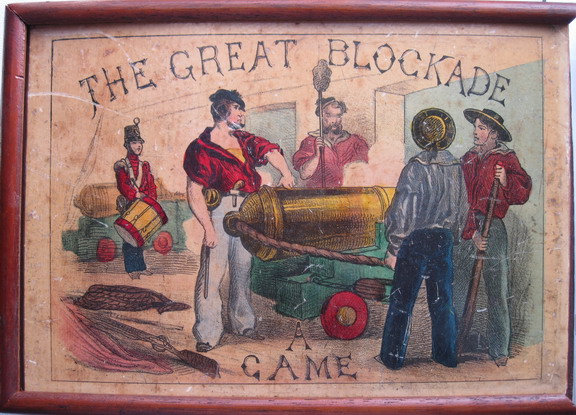 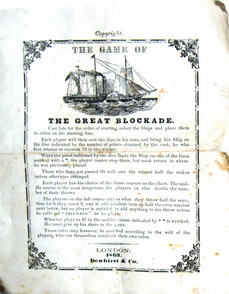 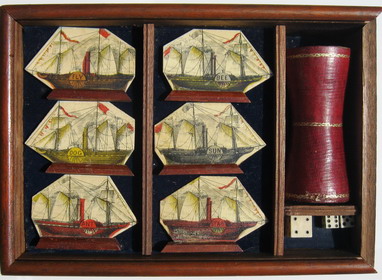 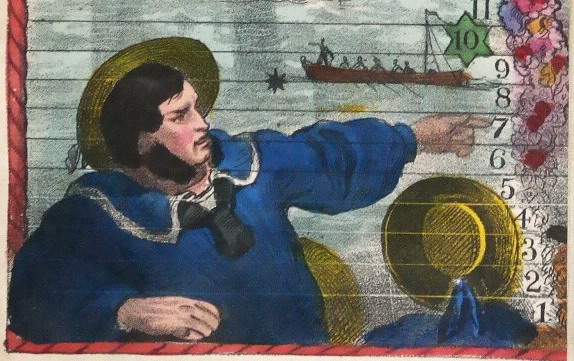 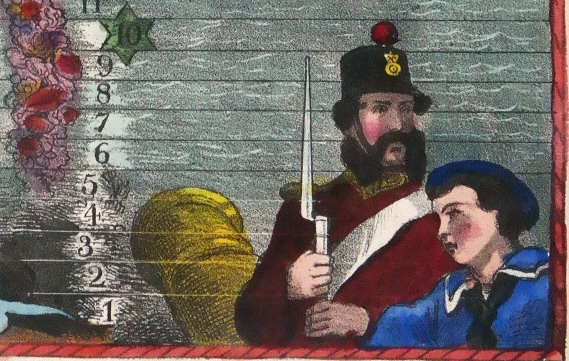 |
primo autore: | Anonimo |
| secondo autore: | Dewhirst&Co. | |
| anno: | 1863 | |
| luogo: |
Inghilterra-Londra |
|
| periodo: | XIX secolo (3°/4) | |
| percorso: | Percorso di 70 caselle numerate | |
| materiale: | carta (paper) (papier) | |
| dimensioni: | 540X380 | |
| stampa: | Litografia colorata a mano e montata su tela (hand-coloured etching backed on linen) | |
| luogo acquisto: | ||
| data acquisto: | ||
| dimensioni confezione: | ||
| numero caselle: | 70 | |
| categoria: | Marina e Aviazione | |
| tipo di gioco: | Gioco di percorso | |
| editore: | Dewhirst&Co | |
| stampatore: | Non indicato | |
| proprietario: | Collezione A. Seville | |
| autore delle foto: | A. Seville | |
| numero di catalogo: | 2286 | |
| descrizione: |
Gioco di 70 caselle numerate. REGOLE: allegate. CASELLE: mute. REFERENZA 1 Game 64: The Great Blockade The Game of the Great Blockade. London: Dewhirst & Co., 1863. Lithograph with original hand color, 54 x 38 cm., dissected and mounted on linen, folding into original mahogany box with hand-painted lid showing a ship-board scene, the box containing six hand-painted ships as playing tokens, plus dice and shaker. Refs.: Ciompi/Seville 2286. This remarkable game, possibly surviving only in the example shown, celebrates the British ships that ran the blockade mounted by the Union against the southern ports of the Confederacy during the American Civil War (1861- 65). Although Britain declared herself to be neutral in the conflict, aiding the supply of materials to the Confederacy was an evident breach of neutrality, a fact implicitly recognized in the Treaty of Washington, when Britain agreed to pay the US some 15 million dollars. The blockade running was largely done by private ships operating out of the Caribbean ports and was highly effective in supplying the Confederacy. Blockade running was also highly dangerous. Many ships were sunk or captured by Union forces and the monetary rewards for both master and crew reflected this. Indeed, fortunes could be made by making just a few successful runs. The game itself embodies the risk/reward trade-off in a remarkable way. The playing sheet consists of three parallel tracks, on which the tokens move according to the throw of a single dice. The rules state that: “Each player has his choice of the three courses on the chart. The middle course is the most dangerous, the players on this double the number of their throws. The players on the left course add to what they throw half the same.... ,“ while those on the safest course on the right add nothing to their throws. Any player on the middle course reaching space 43, marked with a double asterisk, is wrecked and must retire from the game. Single asterisks act as stops, with the player not moving on that throw. The wooden tokens, in the form of ships individually named as “Ant,” ”Bee,” etc., are beautifully hand painted. They represent the class of side-wheel paddle steamers that were built, mostly on the Clyde in Scotland, purposely for blockade running. They were fast and difficult to catch. However, the ships shown on the game sheet are not of this class, though they are meticulously drawn. The artist is not known, though the decorative chains separating the courses look very much like the rose decorations which were the mark of the Barfoots [see game 38]. Nothing is known of the publishers, Dewhirst & Co. (Adrian Seville) Exhibitions: - "The Royal Game of the Goose four hundred years of printed Board Games". Exhibition at the Grolier Club, February 23 - May 14, 2016 (Prof. Adrian Seville). |
|
| bibliografia: |
1) SEVILLE, Adrian: "The Royal Game of the Goose four hundred years of printed Board Games". Catalogue of an Exhibition at the Grolier Club, February 23 - May 14, 2016, pag. 130. |
|
Vai alla ricerca giochi Vai all'elenco autori